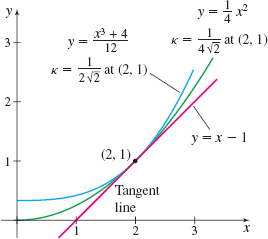EXAMPLE 6Finding the Curvature of Plane Curves
(a) Find an equation of the tangent line to the graph of the parabola f(x)=14x2 at the point (2,1).
(b) What is the curvature of the graph of f at the point (2,1)?
(c) Find an equation of the tangent line to the graph of g(x)=x3+412 at the point (2,1).
(d) What is the curvature of the graph of g at the point (2,1)?
(e) Graph both curves and their tangent lines.
780
Solution (a) f(x)=14x2; f′(x)=12x. An equation of the tangent line to the graph of f at the point (2,1) is y−1=1⋅(x−2)f′(2)=1y=x−1
(b) f′′(x)=12;f′(2)=1;f′′(2)=12. We use formula (9) and evaluate κ at x=2. κ=|f′′(2)|(1+[f′(2)]2)3/2=12(1+1)3/2=12⋅2√2=14√2≈0.177
(c) g(x)=x3+412;g′(x)=3x212=x24. An equation of the tangent line to the graph of g at the point (2,1) is y−1=1⋅(x−2)g′(2)=1y=x−1
(d) g′′(x)=x2;g′(2)=1;g′′(2)=1. The curvature κ at the point (2,1) is κ=|g′′(2)|(1+[g′(2)]2)3/2=1(1+1)3/2=12√2≈0.354
(e) The functions f and g are graphed in Figure 20. Both graphs have the same tangent line at (2,1), but the tangent line to the graph of y=14x2 at (2,1) turns more slowly (κ≈0.177) than the tangent line to the graph of y=x3+412 at (2,1) (κ≈0.354).
